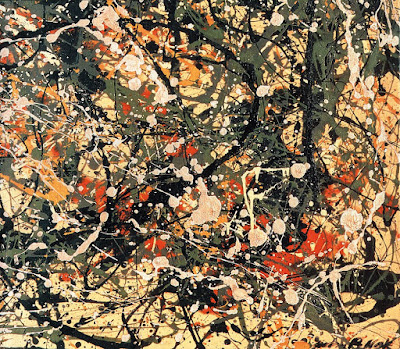Week 2: Math and Art
When we think about a masterpiece in arts, we usually think about paintings hanging from a frame inside a museum. We see the color and we try to decipher the concept behind it, but many times the math and science behind the masterpiece seemed to be unnoticed. Since the renaissance, many different artists have applied mathematical concepts when creating art; concepts that have created bases for the contemporary art world. Mathematics in itself is a whole language that explains patterns of the physical world at small and large extend. Jackson Pollock’s art is a great example of the use of these patterns. His art as fractal patterns seemed to be chaotic but in reality, are based on mathematical ideas. “ They are often the visible remains of chaotic systetms—systems that obey internal rules of organization but are so sensitive to slight changes that their long-term behavior is difficult to predict.” Even though they are difficult to catch this patterns are Pollock’s method to express himself.
 |
| Vitruvian man. |
Concepts like the “Vanishing point” which is characterized by the use of a single point in which the whole perspective of the image or painting is based on. Also, the “golden measurements” which portrayed the idea of the divine or perfect measurements were established and applied not only to painting but also in the European architecture and used around the world to create monuments of which are excellent examples of how mathematics, art, and science can be prompt together.
Sources:
- Dalrymple Henderson, Linda. “The Fourth Dimension and Non-Euclidean Geometry in Modern Art: Conclusion” MIT Press, (1984), pp. 205-210. Printed.
- Ouellette, Juliet. "Pollock's Fractals" http://discovermagazine.com/ 2001/nov/featpoll ock. 2001. Web.
- Pollock, Jackson. https://www.google.com/search?q=vitruvian+man&rlz=1C1CHBF_enUS730US730&espv=2&source=lnms&tbm=isch&sa=X&ved=0ahUKEwim75j7pqrTAhUiw1QKHZsXCAQQ_AUIBigB&biw=1093&bih=471#tbm=isch&q=jackson+pollock+paintings&imgdii=ernZJWUuV5eQJM:&imgrc=cIiR0NG0PRYM-M. Web.
- Unknown, "Vitruvian man" https://www.google.com/search?q=vitruvian+man&rlz=1C1CHBF_enUS730US730&source=lnms&tbm=isch&sa=X&ved=0ahUKEwj9hKjrqKrTAhVLxFQKHXSDAnwQ_AUICCgB&biw=1093&bih=471#imgrc=5ydKnN6yN6NFqM. Web
- Unknow, "Vanishing Point" https://www.google.com/url?sa=i&rct=j&q=&esrc=s&source=images&cd=&cad=rja&uact=8&ved=0ahUKEwjKisH0qarTAhUrilQKHeyOCN4QjRwIBw&url=https%3A%2F%2Fwww.pinterest.com%2Fmndrake%2F2-point-perspective%2F&psig=AFQjCNFbz_kxqvVFxslo-XjiZ820Xqm44g&ust=1492478494253189 Web.
- Vesna, Victoria. “Mathematics.” Lecture. DESMA 9. <https://cole.uconline.edu/~UCLA-201209-12F-DESMA-9-1#l=Week-2-Assignment/id4287887> Web.



Comments
Post a Comment